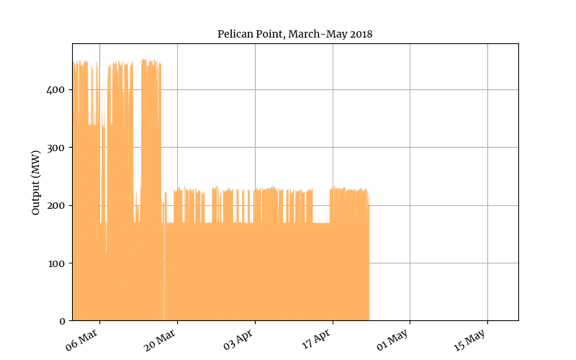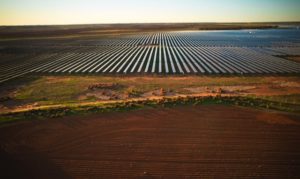The biggest and most modern gas generation units in South Australia have been hit by major problems, with both units out of action for the past month, forcing the market operator to turn to older and more expensive units.
The 478MW Pelican Point power station, about 20km from the centre of Adelaide, is touted by owner Engie as one of Australia’s “most advanced, efficient and environmentally friendly power stations.”
But since April 23, it hasn’t been providing any power to the local grid. And we are not being told why.
 As these graphs above and below show, one unit appears to have wound down for a scheduled outage – presumably for maintenance – from March 17, but the second unit also tripped on the same day.
As these graphs above and below show, one unit appears to have wound down for a scheduled outage – presumably for maintenance – from March 17, but the second unit also tripped on the same day.
It quickly returned to service, but on April 23 the second unit tripped again. Neither unit has returned to service since. (Graphs courtesy of Climate and Energy College in Melbourne).
 This has had a major ripple effect through the grid. New requirements introduced by the Australian Energy Market Operator in the middle of last year mean that a certain number of gas (or diesel) units to be switched on depending on the amount of wind power.
This has had a major ripple effect through the grid. New requirements introduced by the Australian Energy Market Operator in the middle of last year mean that a certain number of gas (or diesel) units to be switched on depending on the amount of wind power.
The absence of Pelican Point has meant that AEMO has had to direct other older and more expensive generators to switch on when they might otherwise have chosen not to.
This table above shows that since the failure of the second unit in April, the number of interventions has doubled to an extraordinary 73 per cent of trading intervals, and an accompanying rise in wholesale prices.
A spokesperson for AEMO said in an emailed statement that Pelican Point “has bid out of the market and remains out due to outages “, but it could not comment on the nature due to “confidentiality” issues.
Engie did not provide a statement by the time of publication.
AEMO said the recent increase in directions are in line with previous system strength requirements for South Australia and are not unexpected during the shoulder seasons.
“Most recently, these directions are driven by low demand, high wind and the need for some generator outages to occur due to maintenance outside the peak demand period,” a spokesperson said.
Still, the interventions have caused some controversy (some think they are overly conservative), but they are likely to be a temporary phenomenon in any case, even as the state pushes well beyond its 50 per cent of wind and solar and new projects are added to the grid.
The state’s transmission operator ElectraNet has outlined plans to install three synchronous condensers at certain parts of the grid. It says this will eliminate the need for directions from AEMO, and also reduce costs to consumers by around $3 to $5 a year.
Pelican Point is nominally capable of providing 25 per cent of South Australia’s electricity needs, but it gained notoriety in February last year when one of its units stood idle as customers had their power switched off because of a lack of supply in the middle of a heat-wave.
That failure prompted the then Labor government to invest in its own energy security plans, which resulted in the Tesla big battery being built, as well as back-up generators that have been installed but so far never switched on.











